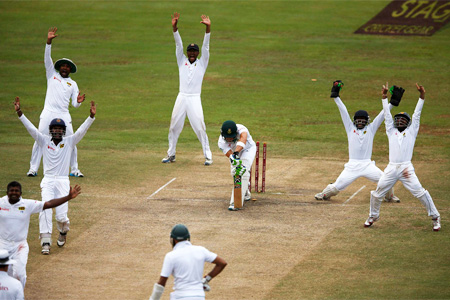 |
Rules
-
The umpire's decision during a game is final in all matters that means no arguing with the umpire, even though you may be sure of his misjudgment. However this is rare these days due to the presence of the third umpire. -
The rules of cricket
define dismissals and if you know you're out within that definition, you are morally obliged to aid the umpire and walk, even though the umpire may have missed the judgment. -
Bowlers are not allowed to tamper with the ball in any way. They can polish the ball by rubbing it with cloth, drying or removing mud from the ball and applying saliva or sweat to it. Any other substance is illegal, as is rubbing the ball on the ground and tampering with the seams.. -
Members of the fielding team cannot distract the batsmen while he is batting. If in case they do that, the umpire can call a dead ball and award five penalty runs to the batting side's total. - Bowler should not keep bowling short or high pitched balls which could cause injury to the batsmen. In such cases, the umpire can call a no ball and warn the bowler.
-
Players in any innings should not waste time in any way. If they do that the umpire first warns the Captain of the offending team and if it continues then five runs are awarded for the other team. -
The new batsman making their way to the wicket is to be applauded. -
All players are responsible to avoid unnecessary damage to the pitch during play. If a fielder damages the pitch then a caution will be issued to the fielding captain. Any repeat action from any fielder during the innings and the umpire will add five runs to the batting side's total. A batsman who damages the pitch will be cautioned by the umpire. If they do it a second time in the same innings, they'll get a final warning and any runs scored from that delivery, other than no balls or wides, will be disallowed. -
Any attempt made to steal a run will see five penalty runs awarded to the fielding side.
Ways in which batsman is dismissed:
-
 A batsman is bowled (out) if the ball hits the wicket and dislodges either bail from the top of the stumps.
A batsman is bowled (out) if the ball hits the wicket and dislodges either bail from the top of the stumps. -
A batsman is out LBW (Leg Before Wicket) if the ball hits the batsman on his pads and in the opinion of the umpire it was pitched on a straight line between the wicket or on the off side and would hit the wicket. -
A batsman is out hit wicket if a ball is dislodged by his bat, body or cap while he is in the act of making his stroke. -
A batsman is out if he hits the ball twice. -
An incoming batsman shall be out if he takes more time to come in. Usually two or three minutes being timed from the moment a wicket falls until the new batsman steps on to the field of play. -
The batsman shall be caught out if the ball hit by him is caught by any fielder before it touches the ground. -
The batsman shall be stumped out when he is out of his crease when the ball is being bowled and the wicket is put down by the wicket keeper. -
The batsman is run out when he is out of his crease while attempting a run and his wicket is put down by any player of the opposite side.Appeal Appeal is the call of the umpire for a decision on whether a batsman is out. If an appeal is not made by the fielding side before the bowler delivers the next ball, the umpires shall not give a batsman out.On appeal, either batsman shall be given out obstructing the field if he willfully obstructs the opposite side by work or action or he willfully obstruct a fielder and prevent a catch being made.
Appeal is the call of the umpire for a decision on whether a batsman is out. If an appeal is not made by the fielding side before the bowler delivers the next ball, the umpires shall not give a batsman out.On appeal, either batsman shall be given out obstructing the field if he willfully obstructs the opposite side by work or action or he willfully obstruct a fielder and prevent a catch being made.
Source- webduniya




